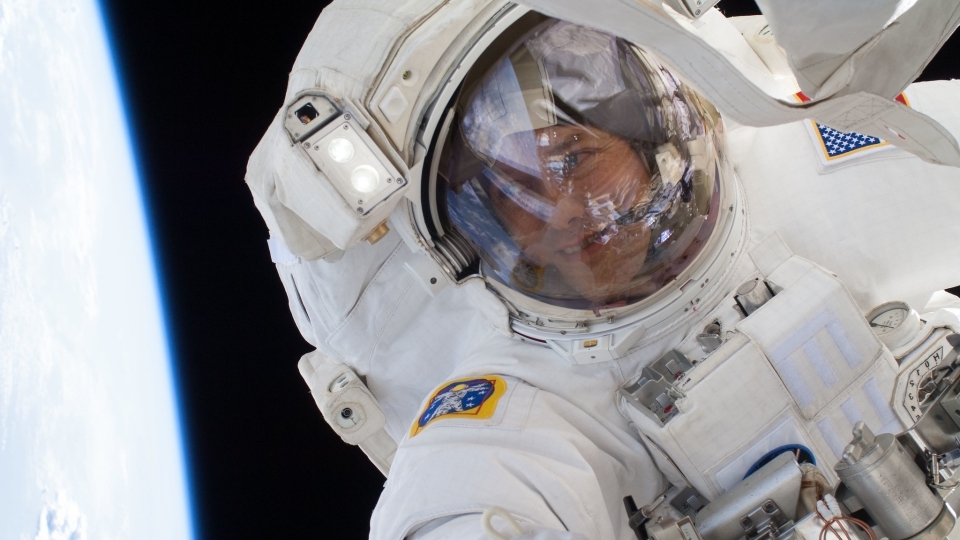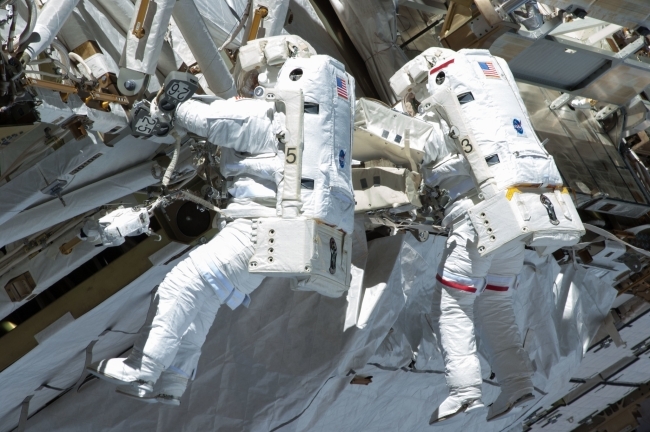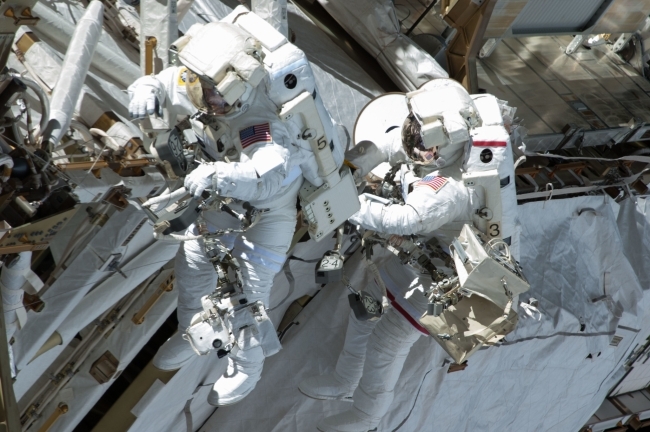Astronauts Are Their Own—and Only—First Responders
March 17, 2021
- Author
- Mark Johnson

Tom Marshburn (pictured) and Chris Cassidy (out of frame) headed out for their spacewalk uncertain of the mission, unsure where the leak was and having never rehearsed the repair. Photo courtesy of NASA.
Astronauts gently float in zero gravity between the 16 pressurized modules of the International Space Station. Pavel Vinogradov, a gregarious and talkative Russian cosmonaut, came flying into the Destiny module where Tom Marshburn was wrapping up the work day near the end of his 2013 mission.
“There are fireworks outside the space station!,” Vinogradov blurted in Russian, recalled Marshburn, a 1982 Davidson graduate who is fluent in the language. He and other crew members were puzzled and startled. They followed Vinogradov to a window where they watched a shower of sunlit, glittering crystals spew like a garden hose from about 50 yards away, on one of the trusses that support the station’s energy-grabbing solar panels.
Leaking something in space is always bad. Apollo 13 commander Jim Lovell’s most heart-stopping words to Mission Control were not about having a problem, but about looking out the left-hand window and seeing the ship’s oxygen venting into space. Think of a gusher of water pouring into a submarine.
Astronauts spend months training for a mission, and a chunk of those days is devoted to safety—how to respond when a tiny meteorite creates a hole in the space station, which happened three years ago, or when a fire breaks out, as it did on the Russian space station Mir in 1997. For a flight to the ISS this fall, Marshburn and crewmates have been practicing emergency procedures for weeks in a mock-up of the station in Houston. They will fly to the station aboard a SpaceX Crew Dragon capsule, so they practice safety protocols for that vehicle at SpaceX’s headquarters in California.
The sparkly spray that Marshburn saw eight years ago, however, was not a scenario he or anyone else had practiced. He and the crew didn’t even know what it was. They radioed Houston on a private channel and sent photos for help to diagnose what was happening. As they first called down, a NASA flight controller saw the ammonia pressure in one of the ISS’s two cooling systems drop. Without ammonia, the system doesn’t cool the solar panels that generate the space station’s power. The panels don’t work, and the station loses electricity.
The Three Worst
Among the possible emergencies in space, “there are three big ones,” said Chad Hammons, a chief training officer for NASA. “Fire, depress(urization) and ammonia.”
The public perceives space travel as routine, more than a half-century after landing on the moon and despite the loss of nearly 30 astronauts and cosmonauts during space missions or training for them. It is fraught with risk, from the precarious arc of launch to the fiery reentry and, in orbit, from the “big three” to the tiny many. Broken glass, for example, is swept up on earth but sends shards floating around the space station that could slice an eye or, if aspirated, a lung. Space amplifies every danger.
“A simple fire that you could walk away from in your house,” said Hammons, who has worked with dozens of astronauts, “is not simple when you can’t leave your house.”
The ISS alarms have three sounds of escalating intensity: caution, warning and emergency. The ammonia emergency for which crews train is if the pure and toxic chemical leaks inside. There’s always an oxygen mask nearby. On the outside, NASA had planned for about a dozen problem scenarios, but the procedures for an ammonia spill into space weren’t ready at the time of Marshburn’s mission.
Failure Not an Option
The ammonia leak created an Apollo 13-like atmosphere among the ground crew in Houston with a surge of personnel working the problem without pause, “sleeping on tables and that sort of thing,” Marshburn said.
“The team down here is working on all options,” Doug Wheelock, an astronaut in Mission Control serving in the role of capsule communicator, or CAPCOM, tells the ISS crew on a recording of the conversation.
NASA engineers could not determine the source of the leak for certain but had a likely suspect: a pump sitting half-a-football-field out on one of the long trusses. The good news, owing to NASA’s famous redundancy, was that a spare pump was sitting in a locker nearby on the truss. Somebody just needed to go swap them.
Marshburn and two others were scheduled to leave in three days aboard a docked Soyuz capsule. His space suit gloves, the only tailored part of space walking gear on the station, were packed for the trip home. A spacewalk typically requires nine weeks of planning.
NASA gave them 36 hours.
What Could Possibly Go Wrong?
A space crew is an amalgam of personalities and careers: PhDs, fighter pilots, medical doctors, engineers. Marshburn is a physician with a master’s degree in engineering and four types of pilot’s licenses. Hammons has to train them to work together and trust procedures.
One member’s individual part may seem counterintuitive, but hundreds of people have gone over the steps, so Hammons has to show them why they’re doing what they’re doing. They have to get themselves safe, first. Then deal with the problem, if they can.
“A lot of repetition, a lot of muscle memory,” Hammons said. “Because we drill so frequently and in so many ways… an emergency doesn’t invoke the same rushed reaction that you might get otherwise. They’re going to react measured and methodical.”
To simulate an electrical fire in training in Houston, Hammons set a small Halloween decoration fan on a laptop. It blows orange streamers straight up in the air, but astronauts treat it seriously.
NASA’s training can’t game out every scenario, so Hammons and others equip the astronauts with the tools and skills they need to figure things out.
Go Fix It
Marshburn had spacewalked before with fellow crew member Chris Cassidy, a former Navy SEAL who deployed to Afghanistan two days after September 11. This time the pair headed out for their spacewalk uncertain of the mission, unsure where the leak was and having never rehearsed the repair.
“In a way it was easier,” Marshburn said, “because we didn’t have procedures to memorize.”
He and Cassidy suited up, exited the airlock and worked their way along the truss. They stuck their heads inside where the pump was and saw nothing suspicious. The leak, if there, had dwindled. The pump, though, remained the likely culprit, so they switched out the 200-pound piece—a fraction of that weight in space. In the course of doing so, a spurt of pure ammonia crystals shot into Marshburn’s faceplate on his helmet. The toxic chemical now was on the suit in which he would reenter the station— another danger.
Then NASA wanted to wait, to let the station make a couple of 90-minute orbits of Earth, allow the sun to hit the pump and make sure the repair worked and would withstand the expansion and contraction of heat and cold.
So, they asked Marshburn and Cassidy to hang on—literally—to handholds, for a couple hours, while they and the station circled the planet.
“In some ways, it’s an astronaut’s dream,” Marshburn said. “You don’t have work to do. Just look around.”
When It Gets Real
Every Monday morning in Houston, representatives from six divisions of the Astronaut Office meet. One is from the safety team. Safety is a constant conversation, Marshburn said. The astronauts put great faith in the engineering of every part and process, still they follow the Russian proverb: trust but verify. They ask questions about individual steps in the process: “What happens then?” Their focus always is on doing their job right, and they have to balance that with staying safe.
Marshburn remembers focusing on the risk at two particular moments. After the months of training and practice for his first flight and first spacewalk, in 2009, everything seemed rote and planned. Then, on launch day, he got in the elevator up to the top of the rocket.
“It’s making noise, it’s groaning, it’s creaking,” he said. “The super cold fuel is creating ice that’s falling off the outside. There’s no one else there, except for the close-out crew. Everybody else is away in case it explodes.”
On the space station, he would make three spacewalks during that mission.
“The dangerous part didn’t hit me until I looked out the window the day before my first spacewalk,” he said, adding that one of his jobs was to operate the airlock—to open the door. “I thought, this was not a simulation… this is a really serious industrial operation. I can’t believe they’re letting me do this.”
Putting the Band Together
When a crew is named, they almost always are working together as a team for the first time. Each member has a slightly different take on how they want to tackle emergencies, said Hammons, the training officer—the pacing, how they divide up roles.
“There’s somebody who works faster, somebody who is more checks and balances,” he said. “Different personalities and different cultures come into play. That influences how they approach a stressful situation. But by the time they fly, they have become a cohesive unit.”
Last week, Marshburn and three crewmates for the fall flight finished Hammons’ final emergency scenario.
The pump repair worked on Marshburn’s 2013 mission. He and Cassidy returned to the station, parking in the airlock for a couple hours to decontaminate any ammonia on their suits. Soon after, Marshburn returned to Earth aboard a Soyuz capsule, landed in Kazakhstan, was checked out by doctors and flew home.
“Four or five days later,” after the station-saving spacewalk, he said, “I was taking out the garbage.”
Additional Coverage
Astronaut Tom Marshburn ’82 to Pilot SpaceX Mission to International Space Station





